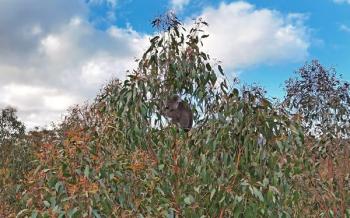
A teratoma in a turkey's eye
Take a peek at how this turkey with a tennis-ball sized tumor was successfully treated.
A 6-week-old male turkey was presented for evaluation of an excrescence the size of a tennis ball (diameter 8 cm) in the area of the left eye (Figure 1). The results of a complete blood count showed evidence of infection (elevated WBC count = 49.5 x 109/L; reference range = 1.7 to 7.5 x 109/L). No abnormalities were found on a serum chemistry profile. Radiographic examination of the head showed that the tumor mass was loosely attached to the sclera but did not penetrate inside the eyeball.
A 6-week-old male turkey with an excrescence the size of a tennis ball in the area of its left eye.
After two days of clinical observation and therapy, enucleation was performed to remove the excrescence (Figure 2). Keep in mind that birds, unlike mammals, have relatively short optic nerves, so exaggerated traction on the globe can result in damage to the contralateral optic nerve, causing blindness in the contralateral eye. Birds have scleral ossicles, which can inhibit enucleation.1,2
A preoperative photo of the tumor mass loosely attached to the sclera.
The cornea was incised and the lens and vitreous were extruded to allow the globe to be collapsed. Intrasurgical observation revealed that the excrescence was a tumor attached to the eyeball. All the lacrimal tissue, the globe, and the eyelid margins were excised.
After excision, the skin was sutured routinely with a gauze swab inside the empty orbit. The swab was changed every day during the 14 days of convalescence. Some surgeons prefer to use an ocular prosthesis to prevent the sunken appearance characteristic of avian enucleation.1 After surgery, the turkey received enrofloxacin (10 mg/kg intramuscularly) for 14 days and celecoxib (10 mg/kg orally) for five days. The sutures were removed 14 days after the enucleation (Figure 3).
The patient 14 days after surgery, before removal of the sutures.
Histopathologic examination
Microscopically, the tumor was composed of glandular structures similar to the intestine, ciliated epithelium resembling that of the respiratory system, and hyaline cartilage that formed various sizes of islands scattered throughout the tumor mass. There were also areas of the embryonal hyaline cartilage and endochondral ossification. The ossicles in the avian sclera were focally hyperplastic. All the tissues comprising the tumor were mature. Based on these findings, a teratoma was diagnosed.
Discussion
Teratomas arise from totipotential germ cells and can give rise to two or more embryonic layers (endoderm, mesoderm, ectoderm) with different types of tissues being present.3 These tumors are not of uniform histologic structure but are a mixture of various randomly intermingled tissues. The exact mechanism of development of teratomas is still unclear. Teratomas are classified as immature (the tissue is not fully mature histologically; malignant) or mature (comprised of mature, fully differentiated tissues; benign).4
In this case, histopathologic examination together with the bird's young age suggested that the tumor could be congenital. The head surface location of the teratoma is rarely described in avian species.5-8 The most common locations in birds are the ovary, testicle, and coelom.9-11
REFERENCES
1. Rosenthal KL, Forbes NA, Frye FL, et al. Rapid review of exotic animal medicine and husbandry. London, Manson Publishing, 2008.
2. Gabrisch K, Zwart P. Praktyka kliniczna: Zwierzeta Egzotyczne. ?ódz: Galaktyka, 2009.
3. Kennedy PC, Cullen JM, Edwards JF. Histological classification of tumors of the genital system of domestic animals (World Health Organization Classification of Tumors of Domestic Animals). 2nd Series, Volume IV. Washington: American Registry of Pathology, 1998.
4. Lo Curto M, D'Angelo P, Cecchetto G, et al. Mature and immature teratomas: results of the first paediatric Italian study. Pediat Surg Int 2007;23(4)315-322.
5. Bolte AL, Burkhardt E. A teratoma in a Muscovy duck (Cairina moschata). Avian Pathol 2000;29(3):237-239.
6. Cullen JM, Newbold JE, Sherman GJ. A teratoma in a duck infected congenitally with duck hepatitis B virus. Avian Dis 1991;35(3):638-641.
7. Ford SL, Wentz S, Garner M. Intracoelomic teratoma in a juvenile bald eagle (Haliaeetus leucocephalus). J Avian Med Surg 2006;20(3):175-179.
8. Homer BL, Riggs MW. Cranial teratomas in two domestic ducks (Anas platyrhynchos domesticus). Avian Dis 1991;35(4):994-998.
9. Cooper JE, Watson J, Payne LN. A mixed cell tumour in a Seychelles kestrel (Falco araea). Avian Pathol 1987;7(4):651-658.
10. Gupta BN. Teratoma in a chicken (Gallus domesticus). Avian Dis 1976;20(4):761-768.
11. Hamir AN. Teratoma in a duck. Vet Rec 1985;117(12):314.
Newsletter
From exam room tips to practice management insights, get trusted veterinary news delivered straight to your inbox—subscribe to dvm360.




